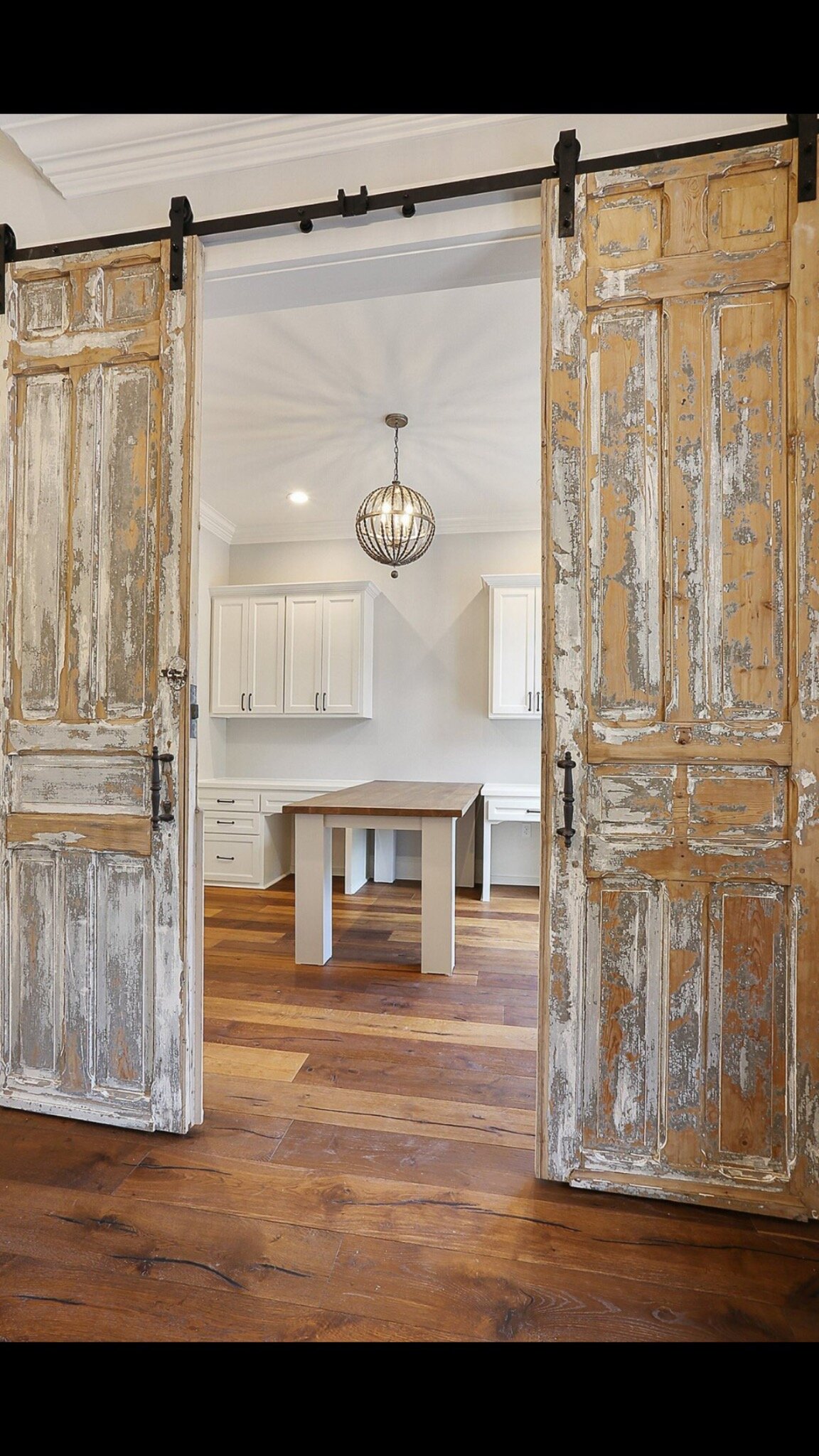A Buyers Guide To Shopping For Antique Doors
A BUYER'S GUIDE TO SHOPPING FOR ANTIQUE DOORS

How do you choose antique doors?
With so many things to consider when building a new home or doing a remodel, we are here to answer your questions about antique doors!
A BUYER’S GUIDE TO ANTIQUE DOOR SHOPPING:
Searching for that perfect antique door can be difficult and sometimes intimidating, but don’t worry, we understand your dilemma and know all of the answers... well, almost all of them. Depending on your current position in the building process, or renovation process, there may be certain questions you need answered before heading off to buy antique doors. And with all of the excitement and chaos that comes along with any house project, it is easy to overlook the details of what it is you need. So in an effort to help make your buying process not only easy, but also fun and exciting (it’s supposed to be exciting right?!), we wanted to provide you with a seller’s perspective on what answers are needed. You as the buyer fall into one of two categories: New Construction or Renovation/Remodel. As you would expect, the new construction category typically allows for more flexibility in terms of what will work for your home, but don’t lose hope for those of you not in the New Construction category, chances are we’ll find the door just right for you.
THE MOST IMPORTANT THING TO KNOW: KNOW YOUR DOOR SIZES
We cannot stress to you enough the importance of knowing what size doors you need when showing up to buy reclaimed doors. It is very easy to get caught up in the beauty of so many doors or a certain look, especially when you show up to a place like The Corbel where there are so many. While you may want a certain look, you are at the mercy of your sizes. Sadly we cannot go back in time and tell them to build the door you want to the size you need. As mentioned before, depending on whether you are building a house or just doing a remodel, you may have more or less flexibility with sizes. But know what your plans call for!
The new construction building process lends itself to be a lot more flexible when it comes to the ability to choose the right doors. While the plans provided by the architect or draftsman call for specific door sizes, framing plans are just that, plans. The architect or draftsman is capable of changing the plan to meet the new dimension of your dream reclaimed doors. Now don’t let that make you squirm, we understand that asking for a change of plans might cause more drama than needed. If the relationship between you and your builder isn’t… Ideal, your contractor will be able to trim down to the size of your door, to some extent.
TOP 10 ANTIQUE DOOR QUESTIONS ANSWERED
1. How will I know if this door will work for my space?
The most important thing you need to know or have access to are the sizes you need. Though there is flexibility that may come with new construction, a starting point is still needed. One great thing we advise our customers to do is to come with plans in hand. Of course we get plenty of customers that are doing a remodel or just replacing a door, in which case just know the size of the hole your door is going into.

2. I’m building and have my house plans, can you look at my door schedule and help me choose?
Any knowledgeable retailer of antique doors should be able to go through your door schedule with you and advise you accordingly on what doors to get. We find this to be very helpful when customers bring this with them to shop for doors. In the event that the retailer you are shopping with is unfamiliar with a door schedule or unable to assist you with it, be careful as to what doors you buy from them, or just come shop with us and we’ll take care of you!
3. Will this particular antique door work even though the dimensions are a little different?
There are very few instances of having an antique door perfectly match and fit the size called by the plans or the hole in a remodel. What you should shoot for is finding a door that is slightly over the size needed and then having the door trimmed down to fit the size. Trimming is typically needed regardless due to the sagging that will occur in the door over its life (100-200+ years). This also goes into the next question of using the existing jamb.
4. Can I stick a reclaimed door into my existing jamb?
The short answer to this question is typically no. It would be a rare occasion for you to be able to place the door in the exact same spot as the previous door. At a bare minimum the hinges on the door have to be replaced and most of the time the door has to be squared on all sides.
5. What type of work needs to be done to an old antique door for it to be a working door?
There are generally three things that need to be done after having purchased an antique reclaimed door. These doors are generally one hundred to two hundred years old which often results in them “sagging” over their lifetime. This means that the doors need to first be re-squared on all sides. The second thing that needs to be done is having door patched. Any remaining hardware on the door that is taken off or other areas of removed parts results in having voids or holes in your door. In which case, those hole would be patched and/or replaced with your new hardware. The third and final thing that needs to be done is the door needs to be put into a new jamb. This is necessary and allows the doors to function because in this process new hinges are put on the door and enable the door to be placed straight into the house.
One important thing to note is that the door will not look “brand new”, hince the point of buying antique doors. The door shops that specialize jambing the door do not sand and finish the door for you. Those two things are typically done on the house site by your painters.

6. How much will prepping an antique door for installation cost me?
One average, when a door needs to be put in a jamb, it will not cost any less than $150. However, the total cost depends on the condition of the door (maybe the door only has two places that need to be patched) and fluxuates with the amount of labor that has to be done on the door.
7. I want an antique door on barn door hardware, what doors will work for that?
Most antique doors can work on barn door hardware, or otherwise known as sliders which work on a track system. These sliders can be found at a variety of online locations including Barndoorshardware.com which is one of our favorites. One cost friendly benefit of sliders is that they do not require the door to be put in a jamb. All you need is the hardware and the doors in the right size, which brings us the main question. You want an antique door that is about 1 inch to 2 inches wider than the opening on both sides.
8. How do I keep the natural color of the door? OR How do I seal in the paint that is on it?
Generally after you get your door back from the door company, your door is going to need to be sanded and finished, most of the time handled by your painter. We recommend two different products for finishing because we personally LOVE the natural color of the doors we sell. So if you love the color of the door, DO NOT use a stain as this will alter the color. We recommend using a water based product by Minwax called Polycrylic. Make sure you buy the “satin” very because you don’t want the door very shiny. This will seal any existing paint that is on the door or the natural color of the wood. Your second option is to hand wax the door using a product called Fiddies. If you instead would love a different color on your door or want to alter it slightly, there is a great product called Briwax which comes in several different color finishes. At the end of the day, you have so many different options as to what you can do with your door, but it all comes down to what you like!
9. If I’m building my home, at what point should I purchase antique doors?
We recommend all of our potential door customers to buy their doors relatively early during the building process because chances are you won’t find the exact right sizes for what your plans call for. By purchasing your doors early, you give your framer the ability to work around the doors you choose. So ideally you would make your door purchases before construction even begins.
10. ENJOY THE PROCESS!
The last thing you want to do is forget to have fun! Whether you’re building your first ever home or it’s your 10th home, you are buying doors that have so much history and beauty. You’re designing and creating a space that you can be proud of and one you will soon have so many people asking about. So don’t get overwhelmed, you have all of your answers now (especially after reading this), and you get to choose the perfect doors for your project!
Be sure to keep up with us on social media @thecorbel to make sure you don’t miss any of the great things soon to come! Now go GET THOSE DOORS!
